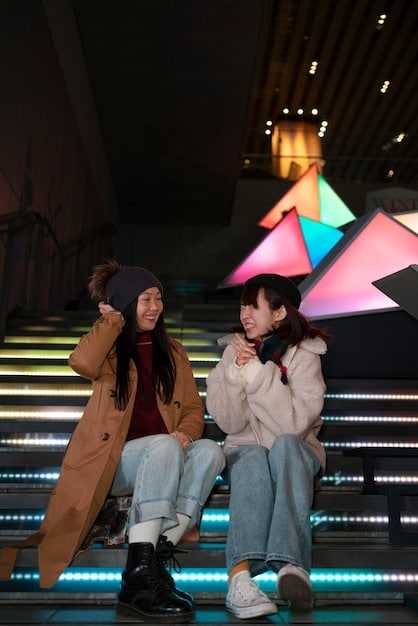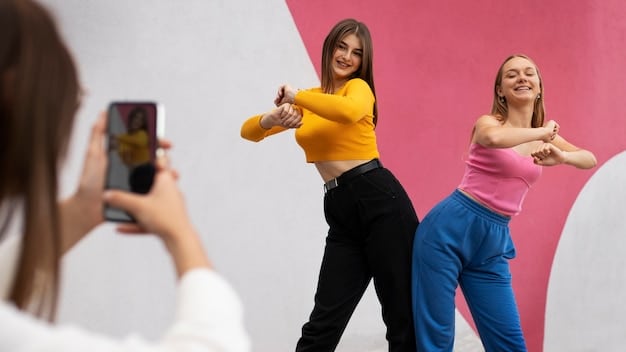The Influence of Social Media on K-Pop: TikTok Trends & Global Success

Social media platforms, especially TikTok, have significantly influenced K-Pop’s global success by enabling viral challenges, direct fan engagement, and broader accessibility, transforming how the genre is consumed and shared worldwide.
K-Pop’s explosion onto the global stage owes much to the dynamic landscape of social media. Platforms like TikTok have become integral to its success, driving trends and fostering unparalleled fan engagement. This article explores the influence of social media on K-Pop’s global success, with a focus on TikTok trends and viral challenges, and offers insights into how these digital phenomena have reshaped the industry.
Social Media: The Launchpad for K-Pop’s Global Invasion
Social media has revolutionized numerous industries, and K-Pop is no exception. It has provided artists with unprecedented control over their image and distribution, bypassing traditional gatekeepers and directly connecting with fans around the world. This section explores how platforms like TikTok, Twitter, Instagram, and YouTube have become essential for K-Pop artists to cultivate a global presence.
From South Korea to Global Charts
The journey of K-Pop from a regional phenomenon to a global sensation is closely tied to the rise of social media. Early platforms like YouTube allowed groups to share their music videos and performances with a wider audience, laying the groundwork for future success. As social media evolved, platforms like Twitter and Instagram became crucial for artists to engage with fans directly, fostering a sense of community and loyalty.
The Rise of TikTok as a K-Pop Powerhouse
While other platforms have played significant roles, TikTok has emerged as a particularly powerful tool for K-Pop artists. The platform’s emphasis on short-form video content has created a fertile ground for viral challenges and trends, allowing K-Pop songs and dance moves to reach massive audiences. This accessibility, combined with the platform’s algorithm, has proven to be a game-changer for the industry.

- Direct Fan Engagement: Social media allows artists to interact directly with fans, responding to comments, hosting live streams, and creating content tailored to their audience.
- Global Accessibility: Platforms like TikTok break down geographical barriers, making K-Pop accessible to anyone with an internet connection.
- Viral Marketing Potential: Social media provides a powerful platform for viral marketing campaigns, with challenges and trends spreading rapidly across the globe.
- Data-Driven Insights: Social media analytics provide valuable insights into audience demographics and preferences, allowing artists to tailor their content and marketing strategies accordingly.
In conclusion, social media has been instrumental in K-Pop’s global success, providing artists with the tools to connect with fans, bypass traditional gatekeepers, and leverage the power of viral marketing. The rise of TikTok, in particular, has proven to be a game-changer, allowing K-Pop songs and dance moves to reach massive audiences around the world.
TikTok Trends: Fueling K-Pop’s Virality
TikTok’s unique format of short-form video content has made it an ideal platform for K-Pop groups to launch viral trends. This section explores the types of trends commonly associated with K-Pop on TikTok, examining the factors that contribute to their success and providing examples of popular trends and challenges.
Dance Challenges and Point Choreography
Dance challenges are a staple of K-Pop on TikTok, with groups often releasing videos showcasing the key “point choreography” from their latest singles. These challenges encourage fans to recreate the dance moves and share them online, generating buzz and driving engagement. The simplicity and catchiness of the choreography are key factors in the success of these challenges.
Audio Trends and Lip-Sync Challenges
In addition to dance challenges, audio trends and lip-sync challenges are also popular on TikTok. K-Pop songs are often used as background music for a variety of videos, creating opportunities for artists to reach new audiences. Lip-sync challenges encourage fans to sing along to their favorite songs, further amplifying the reach of the music.
Successful K-Pop TikTok Trends
- BTS’s “Dynamite” Dance Challenge: This challenge saw millions of fans around the world recreating the iconic dance moves from BTS’s hit song.
- Blackpink’s “How You Like That” Trend: This trend involved users showcasing their fashion and makeup looks inspired by Blackpink’s music video.
- Twice’s “More & More” Point Choreography: Fans recreated the addictive chorus dance using the hashtag, promoting the summer comeback.
In conclusion, TikTok trends have become a powerful tool for K-Pop groups to promote their music and engage with fans. Dance challenges, audio trends, and lip-sync challenges have all proven to be effective in driving virality and expanding K-Pop’s global reach. The creativity and enthusiasm of K-Pop fans, combined with TikTok’s algorithm, have created a perfect storm for success.
The Power of Fan Engagement on Social Media
Fan engagement is at the heart of K-Pop’s success, and social media has provided unprecedented opportunities for artists to connect with their fans. This section explores the different ways in which K-Pop groups leverage social media to foster a strong sense of community and loyalty among their fanbase.
Building a Community Through Direct Interaction
K-Pop groups actively engage with their fans on social media, responding to comments, hosting live streams, and asking for input on their music and performances. This direct interaction fosters a sense of connection and makes fans feel like they are part of the K-Pop journey. This kind of relationship builds strong brand loyalty.
Creating Content Specifically for Social Media
Many K-Pop groups create content specifically for social media, such as behind-the-scenes videos, selcas (selfie pictures), and short skits. This content provides fans with a glimpse into the personal lives of the artists, making them feel more connected and invested in their success.
Fan-Generated Content and User-Generated Marketing
K-Pop fans are incredibly creative and active on social media, creating fan art, fan fiction, dance covers, and other forms of user-generated content. This content helps to promote K-Pop to a wider audience and further strengthens the community. This has organically turned many fans into amateur marketers for their favorite groups.

- Enhanced Brand Loyalty: Active engagement fosters a stronger bond between artists and fans, leading to increased brand loyalty.
- Organic Marketing: Fan-generated content helps to promote K-Pop to a wider audience through word-of-mouth marketing.
- Real-Time Feedback: Social media provides artists with valuable feedback on their music and performances, allowing them to adapt and improve.
In conclusion, fan engagement is a crucial component of K-Pop’s social media strategy. By actively interacting with fans, creating content tailored to their interests, and encouraging user-generated content, K-Pop groups have cultivated a strong sense of community and loyalty, contributing significantly to their global success.
Challenges and Criticisms of K-Pop on Social Media
While social media has been instrumental in K-Pop’s global success, it also presents several challenges and criticisms. This section explores some of the negative aspects of K-Pop’s relationship with social media, including concerns about mental health, online harassment, and the pressure to maintain a perfect image.
The Pressure to Maintain a Perfect Online Persona
K-Pop idols are under immense pressure to maintain a perfect image on social media, constantly monitoring their comments and interactions to avoid negative attention. This pressure can take a toll on their mental health, leading to anxiety, stress, and even depression.
Online Harassment and Cyberbullying
K-Pop idols are often targets of online harassment and cyberbullying, with malicious comments and personal attacks being common occurrences. This can be incredibly damaging to their self-esteem and can have serious consequences for their mental well-being.
Concerns About Mental Health
The intense pressure and scrutiny that K-Pop idols face on social media have raised concerns about their mental health. Many idols have spoken out about their struggles with anxiety and depression, highlighting the need for greater support and awareness within the industry.
K-Pop faces constant scrutiny from the entire world, placing many groups in a precarious balancing act of personality and character. Their management teams usually try to mitigate potential damage.
In conclusion, while social media has been beneficial for K-Pop’s rise to fame, it definitely comes with some risks for the mental wellbeing of the stars.
Monetization Strategies on Social Media for K-Pop
Beyond awareness, K-Pop groups also use social media to drive income. This sections highlights the different ways these groups leverage platforms for revenue generation.
Direct Advertising and Brand Partnerships
K-Pop groups often secure brand partnerships and endorsements. On social media, they will create an affiliate link that tracks how many people purchased something using their link. It is a direct advertising strategy that benefits the groups.
Digital Merchandise
Many groups will have digital merchandise, usually unique to a social media platform, for fans who want to collect and support the groups.
Livestream Ticket Sales
- Concerts: Concerts have been one of the main ways that smaller K-Pop groups earn money.
- Digital Meet & Greets: Fans can pay a fee to digitally meet their idols.
- Digital Masterclasses: K-Pop groups will sell access for digital musical and dance masterclasses.
In conclusion, K-Pop groups have a wide range of ways to monetize their social media presence. They can pick and choose what is best for them, or even combine all of these to maximize revenue.
Future Trends: The Evolution of K-Pop and Social Media
With social media constantly evolving, the future of K-Pop’s relationship with these platforms is sure to shift to new methods. This section goes over areas of potential growth.
The Metaverse
The Metaverse is sure to be a growing part of social media and K-Pop. Concerts and meet and greets can have a much larger attendance volume, which means more revenue.
AI Development
Artificial Intelligence will have an affect on K-Pop, whether for automated music generation or promotion. However, AI will also test the limits to what a real idol is versus an AI based one.
E-Sports
Gaming continues to grow as a social media category. K-Pop groups may partner with E-Sport atheletes and expand their digital presence.
These areas and many more are areas where K-Pop are sure to adapt and grow as the social media landscape continues to shift into the future.
| Key Point | Brief Description |
|---|---|
| 🎵 TikTok Trends | Fuel K-Pop’s virality with viral challenges. |
| 🗣️ Fan Engagement | Strengthens community through direct interaction. |
| 😥 Mental Health Concerns | Pressure of social media impacts idol well-being. |
| 💰 Monetization | Direct brand partnerships and digital goods. |
FAQ
▼
TikTok’s short-form video format has enabled K-Pop groups to initiate viral dance challenges and trends, exposing their music and choreography to a wider global audience, leading to increased recognition and fan engagement.
▼
Successful trends include BTS’s “Dynamite” dance challenge, Blackpink’s “How You Like That” style trend, and Twice’s “More & More” point choreography, all of which garnered millions of views and reproductions.
▼
K-Pop groups engage with fans through live streams, responding to comments, sharing behind-the-scenes content, and creating specific challenges or content tailored for their social media platforms.
▼
Idols face pressure to maintain a perfect image, exposure to online harassment and cyberbullying, and concerns about their mental health due to the constant scrutiny and intense pressures online.
▼
K-Pop acts earn money through direct brand advertising and partnership deals, digital merchandise sales, and ticket sales for livestreamed concerts or digital meet-and-greet events.
Conclusion
In conclusion, the interplay between social media and K-Pop’s worldwide rise cannot be overstated; TikTok especially has shifted how music is spread virally and how fans are engaged. However, even in the face of its own drawbacks, K-Pop can continue using social media for monetization while developing mental health resources.





